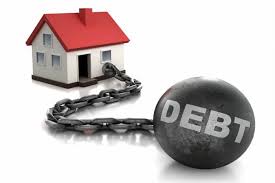
One of the primary tasks a lender must perform is to determine affordability. A mortgage company must make a reasonable determination that the applicants will be able to afford the new mortgage payment along with associated property taxes and insurance. The mortgage includes both an amount to principal and interest. These four payments are referred to by lenders by the acronym PITI. This amount is compared to gross monthly income and arrived at a ratio, called a debt ratio. For most loan programs there are two debt ratios to be evaluated, a “front” ratio and a “back” ratio.
The front ratio is the PITI number. If the principal and interest payment is $2,000, taxes $200 and insurance $100 each month that amounts to $2,300. If the gross monthly income is $6,000, the $2,300 represents 38 percent of income. The front ratio in this example is 38. Adding in additional debt amounts the back ratio. If there is a student loan payment of $100, the back ratio is 40. Other debts that would not appear on a credit report such as a mobile phone bill or utilities are not considered. What are some other types of debt that are counted on top of a mortgage payment?
Besides student loans, automobile loans are included. So too are credit card payments. Daycare expenses can also be included. Any other consumer loans are also included. But debt falls into two primary categories- installment and revolving debt.
Installment debt simply means the loan will be paid off over time in equal installments. At the end of the loan term, the loan is paid off and the note retired. An automobile loan is a type of installment loan. An auto loan might be over a period of 60 months, but other terms are available. As with a mortgage, the shorter the term the higher the monthly payments and the longer the term has lower payments. The tradeoff is the amount of interest paid out over time. An installment loan has a beginning and an end recorded into the note. As with most other types of loans, an installment loan can be paid off sooner either by making extra payments each month or with an occasional prepayment. With an installment loan, when an extra payment is made, the monthly payments still stay the same, even though the loan balance has dropped.
Revolving debt is another type of debt with a credit card being the most common. With a revolving account, the interest rate is applied to the current balance. As more is put on a credit card, the balance increases and so too will the minimum monthly payment. A credit card account does not close down once a balance is paid off. Instead, it’s there for the consumer to tap into when needed. But because the balance rises and falls, which amounts do lenders use when calculating debt ratios?
With installment loans, it’s pretty simple. The monthly payment is clearly stated on the note or appearing in a credit report. however, lenders may also ignore the installment debt if there are less than 10 months remaining on the note. Often times, consumers who are preparing to buy and finance a home can first pay down an existing installment loan to meet the 10-month guideline. Revolving debt, on the other hand, is viewed differently.
Lenders can have different guidelines, but most will simply use the minimum amount required that shows on the credit report. Other types of programs might use the highest monthly payment over the course of the loan that shows on the credit report while still others might calculate the maximum monthly payment the account could ever have. With this method lenders can think the borrowers with a zero balance credit card account can go out the next day and charge up $5,000 which would affect someone’s ability to repay a mortgage.
Some programs allow borrowers to pay down such accounts to lower the monthly payment but can also require the borrowers to not only pay off a credit card but to also close it at the same time. This prevents the borrower from charging up a large amount after the home loan has closed. The lender will need verification the account has not only been paid off but closed entirely.
Again, these requirements can vary slightly based on the loan program, Conventional, FHA, VA, etc.
If you think you might have too much current debt to qualify for a mortgage, don’t make this decision on your own. Instead, speak with one of our loan officers who can guide you through the process. Call us at ph: (904) 342-5507 or just submit the Quick Request Form on this page.
